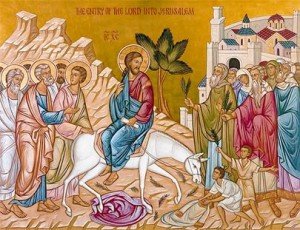 Palm/Willow Sunday largely owes its place as one of the Twelve Great Feasts to its disposition as the first day of Holy Week. Certainly other events of Holy Week – such as Holy Thursday, commemorating the institution of the eucharist – could have been a better claim to theological importance. In the form in which it was generally adopted, Palm Sunday seems to have served as an abbreviation of the succession of events of the Passion which culminated in the next Great Feast: the Crucifixion. In this way the feast of Palm Sunday reinforced the Eastern Church’s conception of redemption and therefore opposed Arianism. Accordingly, when Cyril addressed “that Arian madness” again and again in his homily on Palm Sunday, the feast which was being celebrated seems to have served more as a vehicle for his theological observations than as a theological argument in its own right.
Palm/Willow Sunday largely owes its place as one of the Twelve Great Feasts to its disposition as the first day of Holy Week. Certainly other events of Holy Week – such as Holy Thursday, commemorating the institution of the eucharist – could have been a better claim to theological importance. In the form in which it was generally adopted, Palm Sunday seems to have served as an abbreviation of the succession of events of the Passion which culminated in the next Great Feast: the Crucifixion. In this way the feast of Palm Sunday reinforced the Eastern Church’s conception of redemption and therefore opposed Arianism. Accordingly, when Cyril addressed “that Arian madness” again and again in his homily on Palm Sunday, the feast which was being celebrated seems to have served more as a vehicle for his theological observations than as a theological argument in its own right.
The evolution of the Ascension as an independent feast is somewhat less clear, though its theological implications are more pointed. It marks Christ’s ascension into heaven forty days after the Resurrection as recorded in Acts (1:1-11). The Feast of the Ascension was originally attached to the Core Group, at first being observed as an adjunct to the Resurrection as suggested by the Gospel of Luke, the Epistle of Barnabus, and other sources. Later it came to be celebrated on Pentecost, still on a dependent basis as an aspect of the primary feast of the day it was kept.
The first mention of a festal observance forty days after the Resurrection was again made by Etheria in Jerusalem during Cyril’s episcopate. Unfortunately she did not mention the purpose of this particular observance. She did, however, mention an observance of the Ascension on Pentecost, fifty days after Easter. The Ascension was more or less widespread by 430, but still not celebrated everywhere. The interesting questions are why was it only made an independent feast at that particular time, and why at Jerusalem? Further, if its observance was fairly general by 430, why were some churches still resisting this practice? The evidence suggests that at the time of Etheria’s visit, the observance of the Ascension was evolving from an aspect of Pentecost into a major feast in its own right. That a period of transition would have been necessary is completely understandable: old traditions, especially religious traditions, die hard, and the Ascension had been attached to Pentecost for centuries.
Hopefully this is interesting to you, my readers.
